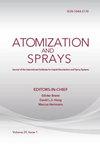Effect of flash boiling and air-assisted injection on methanol spray characteristics
IF 0.9
4区 工程技术
Q4 ENGINEERING, CHEMICAL
引用次数: 0
Abstract
The advantages of methanol as an alternative fuel have been well demonstrated. However, the difficulty of atomization restricts its practical application. Also, flash boiling and air-assisted injection have been shown to improve the atomization quality of fuels. In this work, the methanol spray characteristics with and without air assistance were experimentally investigated. The experimental conditions include flash-boiling and non-flash-boiling states. High-speed backlight imaging and a Malvern laser particle size analyzer were used to obtain the spray images and droplet sizes, respectively. The flash-boiling state caused a significant variation in spray morphology and the formation of high-concentration central plumes with greater velocity. Compared to the non-flash-boiling spray, the droplet size of the central plumes is larger, whereas the peripheral droplets have a smaller particle size. The droplet size of the air-assisted spray at normal temperature and pressure can reach approximately 3.5 μm, whereas that of the methanol spray without air assistance under a strong flash-boiling state is approximately 60 μm, indicating that air-assisted injection can significantly improve the atomization quality of methanol spray. Furthermore, because of the good atomization, the air-assisted methanol spray is significantly affected by evaporation at high temperatures, and no significant transition of a flash-boiling state was observed.闪沸和空气辅助喷射对甲醇喷雾特性的影响
甲醇作为替代燃料的优势已得到充分证明。然而,雾化困难限制了其实际应用。此外,闪沸和空气辅助喷射已被证明可以改善燃料的雾化质量。本研究通过实验研究了有空气辅助和无空气辅助时的甲醇喷雾特性。实验条件包括闪沸和非闪沸状态。利用高速背光成像仪和马尔文激光粒度分析仪分别获得了喷雾图像和液滴尺寸。闪沸状态导致喷雾形态发生显著变化,并形成速度更快的高浓度中心羽流。与非闪沸喷雾相比,中心羽流的液滴粒径较大,而外围液滴的粒径较小。在常温常压下,空气辅助喷雾的雾滴粒径可达约 3.5 μm,而在强闪沸状态下,无空气辅助的甲醇喷雾的雾滴粒径约为 60 μm,这表明空气辅助喷射可显著改善甲醇喷雾的雾化质量。此外,由于雾化效果良好,空气辅助甲醇喷雾在高温下受蒸发的影响很小,没有观察到明显的闪沸状态转变。
本文章由计算机程序翻译,如有差异,请以英文原文为准。
求助全文
约1分钟内获得全文
求助全文
来源期刊

Atomization and Sprays
工程技术-材料科学:综合
CiteScore
2.10
自引率
16.70%
发文量
54
审稿时长
1.7 months
期刊介绍:
The application and utilization of sprays is not new, and in modern society, it is extensive enough that almost every industry and household uses some form of sprays. What is new is an increasing scientific interest in atomization - the need to understand the physical structure of liquids under conditions of higher shear rates and interaction with gaseous flow. This need is being met with the publication of Atomization and Sprays, an authoritative, international journal presenting high quality research, applications, and review papers.
 求助内容:
求助内容: 应助结果提醒方式:
应助结果提醒方式:


